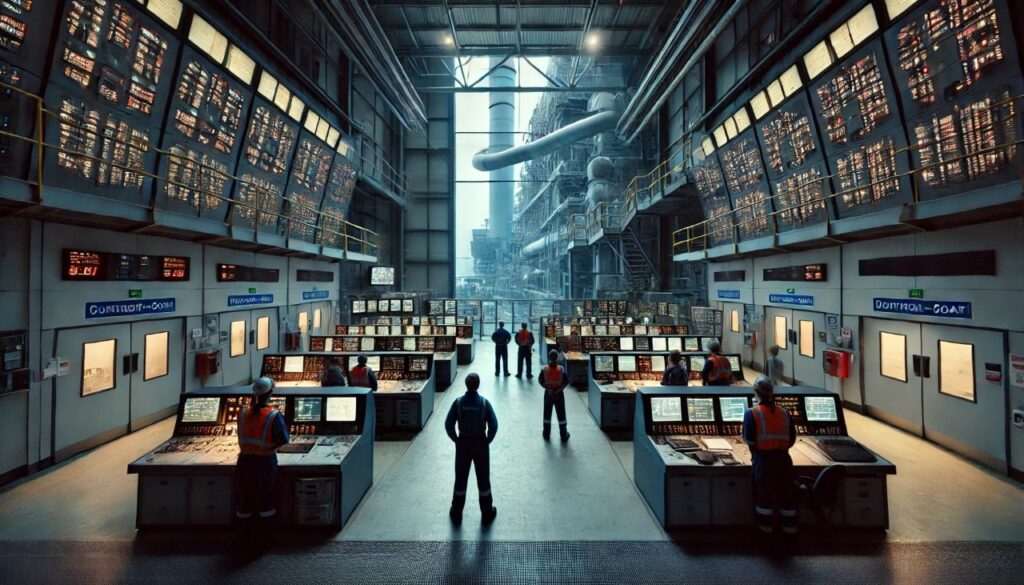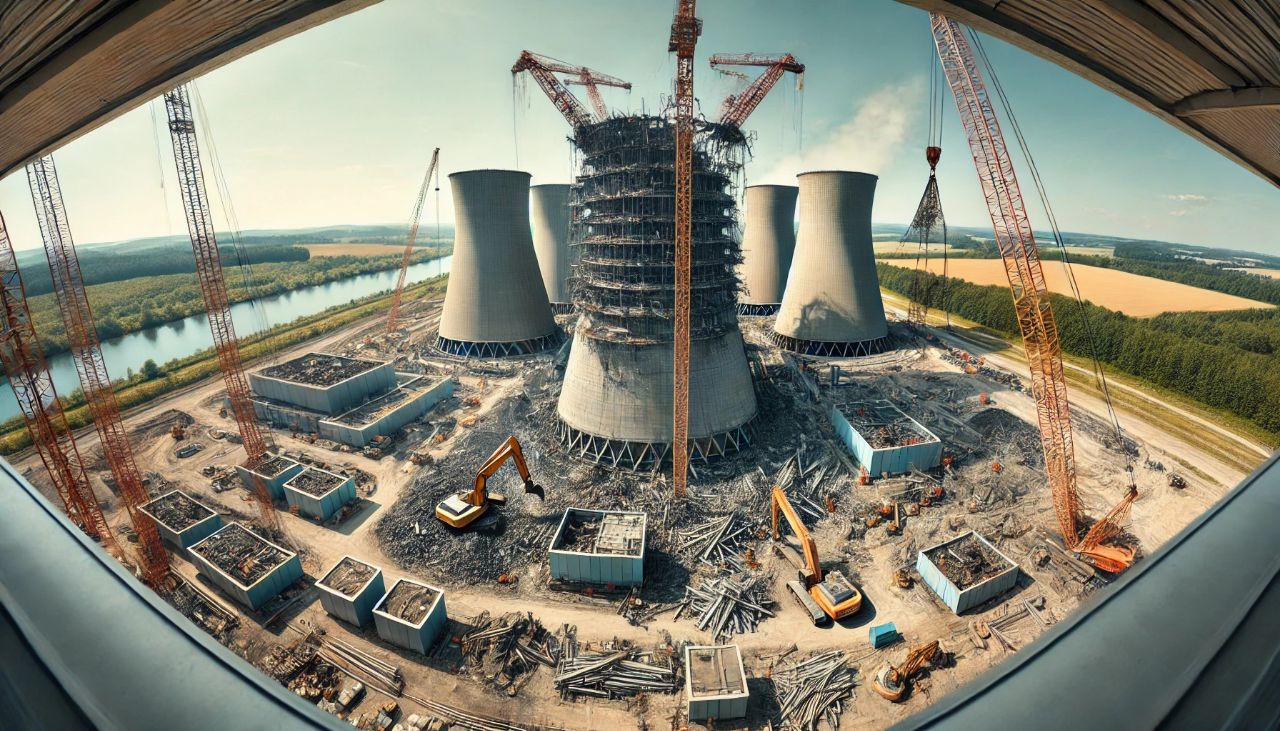On September 30, 2024, Britain marked a historic milestone by shutting down its last coal-fired power plant, the Ratcliffe-on-Soar facility in Nottinghamshire. This event closed a chapter on 142 years of coal-powered electricity in the country that was once the birthplace of the Industrial Revolution. The closure of this power plant is part of the UK’s broader commitment to transitioning toward renewable energy and reducing carbon emissions, which has made it the first major industrialized nation in the Group of Seven (G7) to phase out coal.
The End of Coal in Britain
The Ratcliffe-on-Soar power plant has been operational since 1967, providing power to millions of homes and playing a crucial role in the nation’s energy security for decades. At its peak, the plant employed 3,000 engineers and staff, but by the time of its closure, the workforce had dwindled to 170 due to the gradual decline in coal usage. Coal’s share of electricity production in the UK has fallen drastically over the past few decades. In 1990, coal provided 80% of Britain’s electricity, but by 2023, this figure had fallen to just 1%, with renewable sources like wind and solar taking a much larger role.
The shift away from coal began with the UK government’s commitment nearly a decade ago to reduce carbon emissions. The decision to phase out coal was part of a larger strategy to combat climate change, which includes a goal to generate all of Britain’s electricity from non-fossil fuel sources by 2030. The British government first announced in 2021 that the phase-out of coal would occur by 2025, and by advancing the closure, they were able to demonstrate leadership in international climate efforts.
The Impact on Workers and the Community
For many workers at Ratcliffe-on-Soar, the closure was an emotional experience. Peter O’Grady, the plant manager, reflected on the significance of the event, stating, “This whole year has been a series of poignant moments. I’m sure there will be a few tears as the whole thing stops and as people leave.” Many employees had worked at the plant for decades, with one worker noting that when he started his career 36 years ago, he never imagined a future without coal generation.
In recognition of the transition, the plant’s operator, Uniper, worked closely with labor unions to ensure a “just transition” for employees. Many workers were offered training programs to help them transition into other sectors of the energy industry, while others were redeployed to Uniper’s other power stations. More than 100 workers will stay on at the plant over the next two years to oversee the decommissioning process.
Michael Shanks, the UK’s energy minister, expressed gratitude for the generations of coal workers, saying, “We owe generations a debt of gratitude as a country. The era of coal might be ending, but a new age of good energy jobs for our country is just beginning.”
Britain’s Leadership in Climate Action
The closure of Ratcliffe-on-Soar represents a major milestone in the UK’s leadership on climate action. It is especially symbolic given that Britain was the first country to build a coal-fired power station, with the world’s first coal plant opening in London in 1882. From that point, Britain’s reliance on coal powered the Industrial Revolution, driving economic growth and technological development. However, coal also brought pollution and environmental damage, contributing to global climate change.
By turning its back on coal, Britain is now taking a leadership role in demonstrating how a major economy can transition away from fossil fuels. According to Matt Webb from the London-based research group E3G, “The birthplace of coal power is turning its back on coal forever.”

Phil MacDonald, managing director of global energy think tank Ember, highlighted the significance of the moment by noting how quickly Britain has moved away from coal. “This is the final chapter of a remarkably swift transition from the country that started the industrial revolution,” he said. In fact, the UK’s coal consumption has dropped so dramatically that more than half of its electricity now comes from renewable energy sources such as wind and solar.
This transition is part of a broader global trend, as coal power has halved among Organization for Economic Co-operation and Development (OECD) countries since reaching its peak in 2007. Many countries, especially in Europe, have already phased out coal. For example, Sweden and Belgium ended their reliance on coal even earlier than the UK.
Environmentalists Celebrate, but Challenges Remain
Environmental groups have praised the closure as a major step in reducing Britain’s carbon emissions and addressing climate change. Tony Bosworth, a campaigner with Friends of the Earth, called it a “major achievement,” adding that the next priority for Britain should be moving away from natural gas as quickly as possible and expanding the country’s renewable energy capacity.
However, the shift away from coal has not been without its challenges. Although coal power has been largely replaced by renewable sources in Britain, natural gas remains a significant part of the country’s energy mix. Environmentalists emphasize that more work is needed to reduce reliance on all fossil fuels in order to meet the UK’s 2030 climate targets.
A Changing Energy Landscape
As Britain moves toward a greener future, the site of the Ratcliffe-on-Soar power plant is set to be transformed. Uniper has announced plans to convert the 750-acre site into a “low-carbon energy hub,” which will continue to play a role in the country’s energy strategy but in a cleaner, more sustainable way.
The closure of the last coal plant also signals the end of an era for communities that were once economically dependent on coal. In the 1980s, when Britain’s coal industry began to decline, the closure of mines and coal plants led to significant social and economic upheaval, particularly during the year-long miners’ strike in 1984. Entire towns that once relied on coal for jobs and income were left struggling.
A Broader Global Context
While Britain is leading the charge in phasing out coal, coal remains a major energy source in other parts of the world. In countries like China and India, where energy demand continues to rise, coal consumption remains high. In fact, these two countries accounted for the vast majority of the world’s coal consumption in 2023, pushing global coal use to a record 8.5 billion metric tons. However, there are signs that coal use in China may peak soon, with projections suggesting that the country’s coal consumption could begin to flatten in the next few years as it invests more heavily in renewables.
The UK’s move away from coal is part of a larger, global shift toward cleaner energy sources, though progress varies from country to country. For Britain, the closure of Ratcliffe-on-Soar represents a significant step forward, but it also highlights the broader challenges that remain in transitioning to a fully renewable energy system.
In conclusion, the closure of Britain’s last coal-fired power plant is a major turning point in the country’s energy history. It marks the end of an era that began with the Industrial Revolution and signals the start of a new phase in the UK’s energy future—one focused on renewable energy and a sustainable path toward combating climate change. As the country continues to build its renewable energy capacity, the lessons learned from this transition could serve as a model for other nations seeking to reduce their reliance on fossil fuels.
This article is based on the following articles:
https://www.csmonitor.com/World/Europe/2024/0930/UK-coal-powered-renewable-energy-Britain
https://www.nytimes.com/2024/09/30/climate/britain-last-coal-power-plant.html

Background Information
1. What is Coal and How is it Used?
Coal is a type of fossil fuel, which means it is formed from the remains of plants and animals that lived millions of years ago. It is mined from the Earth and has been used as an energy source for centuries. When coal is burned, it releases heat, which can be used to produce electricity. Coal is considered a “nonrenewable resource” because it takes millions of years to form, and once we use it, it’s gone for good.
The energy produced by burning coal has been used to power homes, factories, and transportation systems, making it an essential part of industrialized societies for over a century. However, burning coal also releases pollutants like carbon dioxide (CO₂), which is a greenhouse gas that contributes to global warming and climate change.
2. The Industrial Revolution
The Industrial Revolution was a period during the 18th and 19th centuries when major changes occurred in manufacturing, transportation, and communication. It began in Britain in the late 1700s and spread to other parts of the world. During this time, many inventions were created that allowed goods to be produced more quickly and efficiently.
Coal was a critical energy source during the Industrial Revolution. It powered steam engines, which were used to run machines in factories, as well as trains and ships. Britain, as the birthplace of the Industrial Revolution, played a leading role in using coal to fuel its growth into a global economic power.
3. The Environmental Impact of Coal
While coal was key to powering economic progress, its environmental effects are severe. Burning coal releases large amounts of carbon dioxide (CO₂), a greenhouse gas that traps heat in the Earth’s atmosphere. This process is called the “greenhouse effect,” and it leads to climate change, which causes global temperatures to rise.
In addition to CO₂, burning coal also releases harmful chemicals and particulates, which contribute to air pollution. This can lead to health problems like respiratory illnesses in people who live near coal plants.
4. What is Renewable Energy?
Renewable energy comes from sources that are naturally replenished and won’t run out over time. The most common types of renewable energy are wind power, solar power, and hydropower (water power). Unlike coal, which releases harmful pollutants, renewable energy sources produce clean energy without releasing greenhouse gases.
As countries around the world work to reduce their carbon emissions and combat climate change, they are turning to renewable energy sources to replace fossil fuels like coal. Wind and solar power are becoming more popular because they are sustainable and environmentally friendly.
5. Why is Climate Change Important?
Climate change refers to long-term shifts in global weather patterns, primarily caused by human activities like burning fossil fuels. This leads to an increase in greenhouse gases, which trap heat in the atmosphere. The effects of climate change include rising temperatures, more frequent and severe storms, droughts, wildfires, and rising sea levels.
Many scientists and governments agree that climate change poses a major threat to life on Earth, affecting everything from ecosystems to human health and economic stability. Reducing the use of fossil fuels like coal is seen as one of the most effective ways to slow climate change.
6. The Role of Governments in Combating Climate Change
Governments around the world are taking steps to reduce carbon emissions and combat climate change. Many countries have signed international agreements, such as the Paris Agreement, which aims to limit global warming to below 2°C above pre-industrial levels, with efforts to limit the increase to 1.5°C. To achieve these goals, countries are working to reduce their reliance on fossil fuels like coal and increase their use of renewable energy.
In Britain’s case, the government set a target to phase out coal by 2025. As part of this plan, the UK has implemented policies like carbon taxes, which make it more expensive to operate coal power plants. These policies have encouraged power companies to switch to cleaner energy sources.
7. The Global Shift Away from Coal
While Britain has now officially ended its reliance on coal for electricity, other countries are at different stages of their transition. In some places, such as the United States, coal still makes up a significant part of the energy mix, though its usage is declining. In contrast, countries like China and India still use large amounts of coal to meet their growing energy needs, which has slowed the global shift away from coal. However, even these countries are starting to invest more in renewable energy as they recognize the need to reduce carbon emissions.
8. The Role of Unions and Workers in Transitioning Away from Coal
The closure of coal plants like Ratcliffe-on-Soar also raises questions about the workers who lose their jobs as a result. In past decades, when coal mines and plants closed, it often led to significant social and economic hardship for the communities that relied on them for employment.
To prevent this from happening again, many governments and companies are trying to ensure a “just transition” for workers. This means providing retraining programs, offering new job opportunities in other sectors, and giving financial support during the transition. In Britain, the workers at Ratcliffe-on-Soar are being supported by Uniper, the plant’s operator, with training and other job opportunities to help them move into different roles in the energy industry.
9. The Future of Energy
As more countries transition away from coal and fossil fuels, the energy industry is undergoing major changes. There is a growing focus on developing new technologies that can generate electricity without harming the environment. These include improvements in wind and solar power, as well as other clean energy technologies like geothermal energy (using heat from beneath the Earth’s surface) and energy storage solutions, which can store electricity generated by renewables for use when the wind isn’t blowing or the sun isn’t shining.
The transition to renewable energy is not only about protecting the environment but also about creating new job opportunities in the energy sector. The renewable energy industry is growing rapidly, and it is expected to continue creating jobs in areas like wind turbine maintenance, solar panel installation, and energy-efficient construction.
Please subscribe to Insight Fortnight, our biweekly newsletter!
